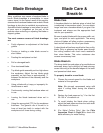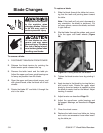
-28-
G0640X 17" Wood/Metal Bandsaw
Tooth Style
When selecting blades, another option to con-
sider is the shape, gullet size, teeth set and teeth
angle—otherwise known as “Tooth Style." Many
blade manufacturers offer variations of the four
basic styles shown in
Figure 37.
Standard
: This style is considered to be the
standard because the tooth size and shape are
the same as the tooth gullet. The teeth on these
blades usually are very numerous, have no angle,
and produce cuts by scraping the material; these
characteristics result in very smooth cuts, but do
not cut fast and generate more heat than other
types while cutting.
Skip
: This style is similar to a raker blade that is
missing every other tooth. Because of the design,
skip toothed blades have a much larger gullet
than raker blades, and therefore, cut faster and
generate less heat. However, these blades also
leave a rougher cut than raker blades.
Hook
: The teeth on this style have a positive
angle (downward) which makes them dig into the
material, and the gullets are usually rounded for
easier waste removal. These blades are excellent
for the tough demands of resawing and ripping
thick material.
Variable Pitch: These blades typically feature
combinations of tooth styles that provide qualities
of both
.
Figure 37. Bandsaw blade tooth types.
Tooth Set
Three of the most common tooth sets are alter-
nate, wavy, and raker (see Figure 38).
Alternate: An all-purpose arrangement of bend
-
ing the teeth evenly left and right of the blade.
Generally used when exceptionally smooth, pre
-
cise cuts are needed for cutting wood or mild
steel.
Wavy:
Generally three or more teeth in a group
that are bent one way with a non-set tooth before
the next group bent the other way. Typically used
for straight cuts in thin metals or thin-wall tubing.
Generally not used in woodworking.
Raker:
There are three teeth in a recurring
group—one bent left, next one bent right, and
then a non-set tooth.
The raker set is ideal for
clearing chips on thick stock. It is often also used
with contour, profile, and long cuts. This type of
set leaves rough cut marks.
Tooth Pitch
Usually measured as TPI (teeth per inch), tooth
pitch determines the size/number of the teeth.
More teeth per inch (fine pitch) will cut slower,
but smoother; while fewer teeth per inch (coarse
pitch) will cut rougher, but faster. As a general
rule, choose blades that will have at least three
teeth in the material at all times. Use fine pitched
blades on harder woods and metals and coarse
pitched blades on softer woods and metals.
Figure 38. Bandsaw tooth sets.
Alternate Wavy Raker


















